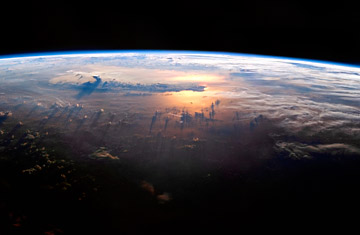
The Pacific Ocean seen from space — a cozy spot for extraterrestrial microbes to land. Image from Michael Benson's new book, 'Planetfall.'
The fireball bearing down on the little town of Tata, in southwestern Morocco, in July 2011 was like nothing the locals had ever seen. There was one sonic boom, then another as a yellow slash of fire cut across the sky. The yellow turned to a landscape-illuminating green, the fireball split in two, and a hail of smoldering rocks crashed to the ground across the surrounding valley. With that, the planet's latest invasion from Mars was over.
Scientists quickly pounced on the incoming ordnance, dubbed the Tissint meteorite after the type of rock it was made of. They wanted to know its chemistry and mineralogy--which proved it came from Mars--and they wanted to know one more important thing: whether it was carrying passengers. It's a question space scientists have begun asking a lot.
Life, as far as we can prove, exists only on Earth. There is our modest planet circling our modest star, and then there is the unimaginable hugeness beyond. Yet in that whole, great cosmic sweep, we're the only little koi pond in which anything is stirring. That, at least, has been the limit of our science. But that limit is changing fast.
The cosmos, as scientists now know, is awash in the stuff of biology. Water molecules drift everywhere in interstellar space. Hydrogen, carbon, methane, amino acids--the entire organic-chemistry set--swirl through star systems and dust planets and moons. In 2009, NASA's Stardust mission found the amino acid glycine in the comet Wild 2. In 2003, radio telescopes spotted glycine in regions of star formation within the Milky Way. And meteors that landed on Earth have been found to contain amino acids, nucleobases--which help form DNA and RNA--and even sugars.
That raises a tantalizing question: If the building blocks of life can rain down anywhere, why not life itself--at least in the form of bacteria? Such an improbable idea--dubbed panspermia--has been chattered about by scientists since the 19th century. But back then, there wasn't much knowledge of what the cosmic ingredients of life would be or how to detect them even if they could be identified. That's all changed. A welter of new studies in the past few years have shed light on the panspermia idea--and, in the process, have changed our very sense of our place in the cosmos. Never mind the old image of life on Earth existing in a sort of terrestrial bell jar, sealed off from the rest of the universe. Our planet--indeed all planets--may be more like a great meadow, open to whatever spores or seedlings blow by.
"I think there's definitely a role meteorites have to play in at least getting prebiological materials to planets," says Chris Herd, a meteorite expert at the University of Alberta, who has studied the Tissint rocks. "A lot has to go right for an actual microorganism to go from planet to planet. But in some cases, they just might survive the trip." If they made that trip to the ancient Earth, we may not merely have encountered aliens; we may be the aliens.
Martian Misfire
The search for life in rocks from space has not always been smooth. On Aug. 6, 1996, NASA stunned the world with a midday press conference announcing that a meteorite from Mars, prosaically known as ALH84001, contained evidence of what appeared to be fossilized bacteria.
